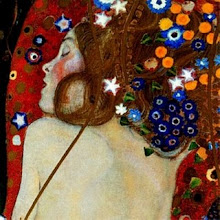Marie Curie
"Life is not easy for any of us. But what of that? We must have perseverance and above all confidence in ourselves. We must believe that we are gifted for something and that this thing must be attained."
Marie Skłodowska Curie was the first woman to win a Nobel Prize (one of only two people to have won two: Physics, 1903, shared with Pierre Curie; Chemistry, 1911) and the first female professor at the University of Paris. Curie's work centered on radioactive elements. She coined the term radioactivity, after her studies of pitchblende revealed the elements radium and polonium in the uranium containing mineral. A physicist by training, she also advanced the idea of treating neoplasms, growths either malignant or benign, with radiation. She met her soul mate in Pierre Curie, a chemist and physicist at the Sorbonne, in 1893. After a brief time apart during which she returned to her native Poland to (unsuccessfully) seek a position teaching at Krakow University, she returned to Paris and they married 1895. In the eleven years that followed they were seldom if ever apart and seldom out of their laboratory.
Marie Curie was the first to realize that known salts of uranium had a second element in them. After years of painstaking separation, the element of radium was isolated by the technique of differential crystallization. A difficult process that absorbed the Curies over the course of four years, they were able to isolate 0.10 gram of radium chloride salt from one metric ton of pitchblende by 1902. (The Curies were unaware of its toxic effects.) By 1910, four years after the tragic death of Pierre Curie in an accident on the streets of Paris, Marie Curie had isolated the pure radium metal. In an act of true scientific generosity of spirit, Marie Curie never sought to patent her process for obtaining pure radium. She wanted the scientific community to have easy access to it.
What is less well known is the dark intrigue that surrounded Marie Curie in Paris in the years following Pierre Curie's death. While the mother of two worked on in the lab, in utter despair for a time, she also embarked on a shocking, for its day, love affair with one of Pierre's students, Paul Langevin, who was separated from his wife. The scandal, which was in part brought to light by his disgruntled and estranged wife, almost completely derailed Marie Curie's career. Because of her Polish heritage, she was already suspect in the eyes of the French. The affair and its publicity were literally almost the final straw. Socially ostracized for a time, the affair also almost cost her the second Nobel Prize. It was at the insistence of colleagues of Curie that the Nobel committee moved forward with the controversial award. They felt her work so far exceeded any notoriety that the Committee should focus on her achievements. (What a concept...)
Imagine how remarkable her work was that in 1910-11 male colleagues stepped forward to defend her, defend her work and seek to laud her for it?
Marie Curie died in 1934 from aplastic anemia, a condition indicative of complete bone marrow failure in the production of blood cells. It almost certainly was due to the massive exposure to radiation over the many years of research. Indeed, areas of her preserved laboratory in Paris still glow in the dark to this day.
Observed Cornell professor L. Pearce Williams:
"The result of the Curies' work was truly epoch-making. Radium's radioactivity was so great that it could not be ignored. It seemed to contradict the principle of the conservation of energy and therefore forced a reconsideration of the very foundations of physics."
























A true hero, who epitomized the definition of "scientist"
ReplyDelete